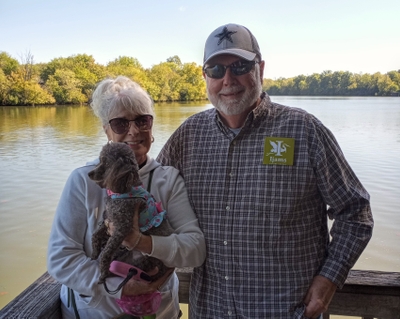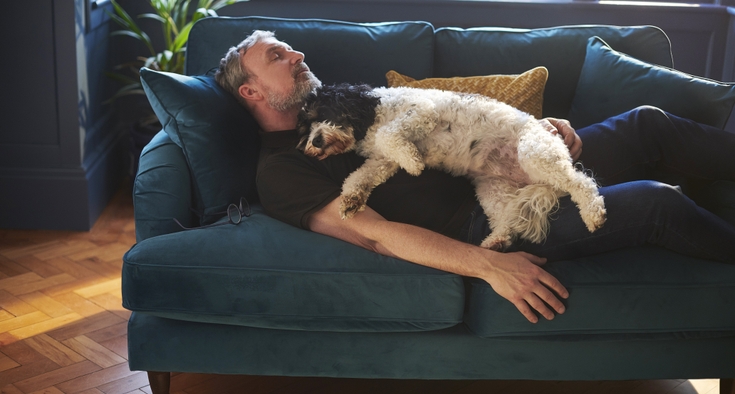By Page Leggett, Novant Health Healthy Headlines
To find and book a physician click here.
Dennis Bollinger didn’t realize why he felt tired every morning after getting what he thought was a full night’s sleep.
It was 2016, and he and his wife, Fawn, were living in San Antonio, where Bollinger owned a food-service business. Fawn used to wake him up to tell him he was struggling to breathe. A sleep study in 2016 revealed he had severe sleep apnea. His cardiologist told him he’d literally quit breathing multiple times while asleep.
In addition to your disrupted sleep – and your partner’s – untreated sleep apnea can significantly increase your chances of heart trouble. Bollinger was outfitted for a CPAP (continuous positive airway pressure) machine to help him breathe at night.
Bollinger, now 72, retired and living at Lake Wylie, South Carolina, never got used to the machine.
He traveled for business. He and Fawn also love traveling for pleasure – in retirement, they bought a 45-foot RV. Bollinger disliked having to pack his CPAP and take it on the plane with him. Cleaning it on the road was a pain.
Even worse, he didn’t feel he was sleeping better with the CPAP. The machine frequently woke him up. “Sometimes, it would leak around my mouth and nose, and that would cause the air to rush at me,” he said.
When he’d stop breathing, the machine would blow air at him, too. He’d turn it off, turn it back on and adjust it to get the airflow started again. “I just thought this was how it had to be,” he said.
But then he saw a TV commercial for the Inspire implant.

He called his primary care physician, who referred him to Dr. Nancy Behrens of Novant Health Sleep Medicine – Ballantyne.
“Inspire is for people who have moderate to severe sleep apnea and who have struggled, or cannot get consistent benefit, with CPAP,” Behrens said. “They have to be at least 18 and not significantly obese.”
Getting approved by your insurance company for the device takes time and patience. It took Bollinger nearly nine months to qualify.
“Some people have obstructive sleep apnea, which is when your airway closes and blocks your breathing,” Behrens said. “Some people have central apnea, which is a pause in breathing – related to heart issues, neurologic issues or to taking opioid pain medication – that would not be improved with Inspire. And people can have other sleep or health issues. If somebody has significant anxiety and insomnia – or chronic pain – Inspire likely won’t cure those problems.”
Someone newly diagnosed with sleep apnea is not a candidate for Inspire, either.
Bollinger first saw Behrens in December 2021. She ordered a sleep study, which he was able to do at home. The study showed his obstructive sleep apnea to be severe enough to warrant Inspire. With obstructive sleep apnea (OSA), the person is trying to breathe and sometimes gasping for air. With central sleep apnea, the brain doesn’t send the signal to inhale and exhale, so there is no movement.
The risk level of someone’s sleep apnea depends upon the severity of it, Behrens said – how many times they stop breathing and how low the oxygen level (which can lead to heart and brain disease) drops. “Sleep apnea can also be dangerous when it leaves people excessively sleepy during the day, putting them at greater risk for car accidents,” she added.
Behrens explained how the process works: “The first step is the patient seeing a sleep specialist, reviewing their most recent sleep study and determining if there are other contributors to their sleep problems. We review their health, medications and their most recent use of CPAP and how that’s going. Then, if they seem to be a candidate for Inspire and express interest, we get an updated sleep study if it’s been over a year since the last one and refer them to an ear, nose and throat specialist who can implant the Inspire device.”
Do you qualify?
But it’s still not time for the implant. There’s more testing to do. In the operating room, an ear, nose and throat (ENT) doctor does a sedated airway exam – called a “drug-induced sleep endoscopy” – in which a flexible endoscope is used to see how the airway closes.
Dr. Adam Gigliotti of Charlotte Eye, Ear, Nose & Throat Associates has performed many Inspire implant operations. The patient is given anesthesia, and then Gigliotta uses a flexible endoscope to study the “collapse pattern” during an endoscopy. “Essentially, if their throat collapses front to back, then the device should work, and we can carry on with the approval process,” he said. “If the top part of their throat collapses side to side (called complete concentric collapse), the device is not likely to get us the result we’re looking for.”
In people with sleep apnea, their throat pulls inward and blocks off breathing. “Throat collapse” refers to which direction that’s happening.
Tony Velazquez, 51, who owns Unique Window Tint and Body Shop in Charlotte, used a CPAP for nearly 14 years, but was never completely satisfied with it for the same reasons Bollinger listed. “The CPAP would leak, and the mask would get askew during the night,” he said. “And I had to tote it with me every time I went out of town.”
Velazquez needed to lose about 70 pounds before he could have Inspire surgery, which he did. Gigliotti implanted his device in 2017. “I can feel the implant in my chest,” he said. “But no one can see it.”
He’s now getting six to seven hours of sleep a night and feels rested when he wakes up. He appreciates being able to sleep on his side again. With his CPAP, he had to sleep flat on his back.
Getting the implant
If you prove to be a good candidate and are approved by your insurance company, you can be scheduled for the outpatient procedure, meaning you go home the same day.
Inspire surgery is performed under general anesthesia. “There are two incisions,” Gigliotti said. “One is under the chin, and through that, I find the nerve that moves the tongue. I separate the branches that move the tongue forward from those that move the tongue backward. And then I put a cuff around the forward branches; there’s a wire on that cuff that’s then tunneled underneath the skin to a second incision through the chest wall. We put the generator underneath the skin on top of the pec muscle. A second wire is placed between two of the patient’s ribs. Once that’s all connected, we anchor everything down, test it, close the incisions and then wake the patient up.”
There are no incisions inside the throat, which makes recovery much easier than traditional sleep apnea surgery. Gigliotti likes the Inspire implant because “it works on the tongue and the palate.”
“We’re addressing two areas of collapse with one procedure,” he said.
Both he and Behrens say that Inspire works really well for the right patient, but there’s a risk that it doesn’t completely treat your sleep apnea. “That’s something we tell patients going in,” he said.
Now what?

Bollinger healed quickly from his surgery, which he had in the fall of 2022. “The day after the procedure, I was eating and drinking and doing all the things I normally do,” he said.
There’s a crucial component that goes with the Inspire implant – a remote control – but you don’t go home from surgery with it.
Patients continue to use a CPAP for three to four weeks until they heal. Then they come back to the sleep specialist, who turns on the device and shows them how to use the remote control, Behrens said. “We have a tablet that communicates with the device, and we establish the initial settings for it. The patient will turn on the remote control at bedtime and slowly, over weeks, increase the stimulation.”
The stimulation to their tongue moves the tongue forward and opens the airway. After a few months on Inspire, the patient has another in-lab sleep study that helps the doctor fine-tune the device.
“It can be a really positive experience,” Behrens said. “But it is definitely a process to identify who’s right for it. We have a few patients for whom it’s not as effective as we had hoped. We work hard to make sure patients understand that it’s not just a matter of turning it on and having everything work perfectly. There can be some fine tuning involved.”
Once the device is implanted, patients need to see their sleep specialist every six months to a year. The doctor gets data about usage and how the device is working for the patient. “If something changes for somebody – if they gain or lose weight, for instance – we might need to change their stimulation settings,” Behrens said.
If a patient isn’t happy with Inspire, the device can be surgically removed.
‘I love the simplicity’
Many Inspire patients say the device has been life-changing. But doctors say it’s never the first option.
“If you can tolerate your CPAP, then that, in many cases, is the safest option,” Gigliotti said. “But Inspire is much easier to tolerate and has excellent results when compared to many other surgeries.”
Behrens said most of her patients do very well with their CPAPs, but some – like Bollinger and Velazquez – struggle for years and never get comfortable with it.
For patients with mild sleep apnea, Behrens recommends a CPAP, a dental appliance or weight management. “All of those can be effective,” she said. “If the sleep apnea is more than mild, typically CPAP is the best treatment.”
For patients who qualify for Inspire, “it’s really nice for them to sleep without being bothered by snoring or having to wear a mask,” Behrens said. “We love seeing patients who are successful with it because it’s very different from anything we’ve been able to offer before.”
Bollinger, whose device was implanted by Dr. Joshua Levine, is a believer.
“I don’t miss cleaning those hoses and dealing with filling and dumping the water in the machine every day,” he said. “I used to have to carry it in a separate bag; I never could get it in my suitcase. I’d have to take it with me on airplanes, on road trips. It was really annoying. Now, all I have is a remote. The technology’s incredible.”
“I love the simplicity of it,” he said. “I just push a button on the remote and go to sleep.”
At his most recent appointment with Behrens, the readings from his device indicated he’s getting seven-and-a-half hours of sleep a night. And he never wakes up during the night anymore. Insurance covered nearly 100% of the procedure. Bollinger said he paid only $75 out of pocket.
He’s raved about it so much that his brother in Arizona was tested and recently had Inspire implanted.
The Inspire implant may not be for every sleep apnea patient, but for many who can’t tolerate – or who never get comfortable with – a CPAP, the device can be life-changing.
Novant Health
Healthy Headlines
Facebook
Instagram
Twitter
YouTube




